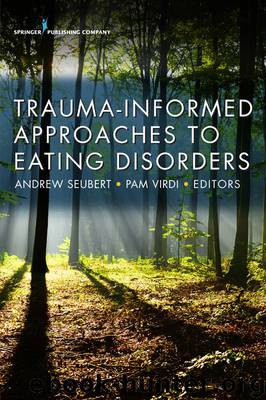Trauma-Informed Approaches to Eating Disorders by Andrew Seubert

Author:Andrew Seubert
Language: eng
Format: epub
Publisher: Springer Publishing Company
Published: 2018-07-19T16:00:00+00:00
PHASE 8: REEVALUATION
In the follow-up session and to ensure the past memory has been thoroughly addressed, the EMDR clinician will go back to the original target and “reevaluate” to ensure the target remains neutral or if something else, undetected earlier but related, has come up. This can be the result of the “onion” effect where earlier undetected layers that support the ED become apparent as the result of EMDR processing. The clinician will ask at the next session: “When you think about the original memory that we worked on last time, on a scale of zero to 10, how disturbing is it to you now?” The therapist also inquires about the status of the VoC: “And when you hold the memory and the positive belief (PC) in your awareness,” how true does the PC feel on a scale of 1 to 7? If the target remains neutral or a zero, and if the VoC remains at a 7, the therapist will address the second part of what is known as EMDR therapy’s three-pronged protocol. EMDR therapy is a comprehensive psychotherapy that not only addresses the past events and experiences that laid down the bases for the ED (the first of the three prongs) but also further addresses current events triggering the ED in the present-day life (the second of the three prongs). This is accomplished by asking if there are similar or related experiences that are currently triggering, and then proceeding to desensitize the current triggers before moving on to the third prong.
The EMDR therapist also addresses future potential challenges or triggering events with future template work to complete a comprehensive treatment plan. The future template is the third prong in the EMDR three-pronged protocol. In the future template work, the client is asked to imagine similar triggering events that might happen in the future while accessing resources (positive thoughts, feelings, and outcomes resulting from previous processing). The client is asked to run a “video” of himself or herself responding in new, healthy ways to future incidents and experiences that would have resulted earlier in ED thoughts and behaviors. Another avenue in the future prong would be to apply the standard EMDR protocol to what the client fears would be the worst possible outcome in a future challenge.
Download
This site does not store any files on its server. We only index and link to content provided by other sites. Please contact the content providers to delete copyright contents if any and email us, we'll remove relevant links or contents immediately.
Binge by Oakley Tyler(889)
Unbearable Lightness by de Rossi Portia(780)
You Can Drop It! by Ilana Muhlstein(733)
Warrior by Theresa Larson(713)
Eating Disorders by B. Timothy Walsh(704)
This Is Big by Marisa Meltzer(648)
Acceptance and Commitment Therapy for Eating Disorders by Emily Sandoz(581)
Unbearable Lightness, A Story of Loss and Gain by Portia De Rossi(514)
Your Body, Your Best Friend by Erica Mather(499)
Beauty Begins by Chris Shook(490)
The Ministry of Thin - How the Pursuit of Perfection Got Out of Control by Emma Woolf(484)
The Happy Hoofer by Celia Imrie(472)
Diet Recovery: Restoring Hormonal Health, Metabolism, Mood, and Your Relationship with Food (Diet Recovery Series Book 1) by Matt Stone(465)
DR. SEBI ALKALINE RECIPE: A Complete Guide On Dr. Sebi’s Alkaline Electric Recipes Using The Sebian Food List And Ingredients by Carin C. Hendry(464)
Unbearable Lightness: A Story of Loss and Gain by Portia de Rossi(460)
Full-Filled by Renée Stephens(449)
Trauma-Informed Approaches to Eating Disorders by Andrew Seubert(421)
Fat, Pretty, and Soon to be Old by Kimberly Dark(406)
8 Keys to End Emotional Eating (8 Keys to Mental Health) by Howard Farkas(404)
